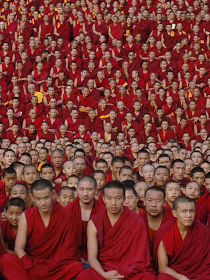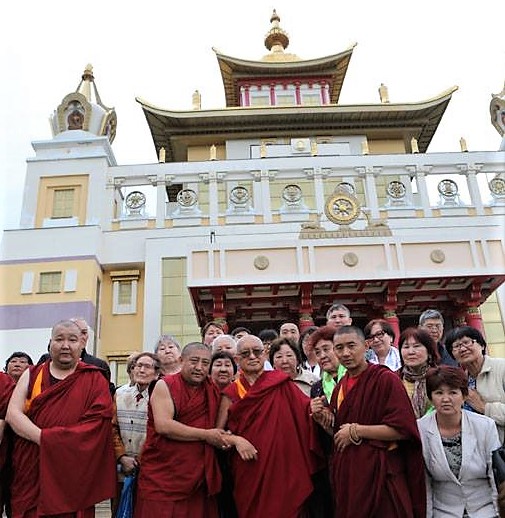- Home
- FPMT Homepage
Foundation for the Preservation of the Mahayana Tradition
The FPMT is an organization devoted to preserving and spreading Mahayana Buddhism worldwide by creating opportunities to listen, reflect, meditate, practice and actualize the unmistaken teachings of the Buddha and based on that experience spreading the Dharma to sentient beings. We provide integrated education through which people’s minds and hearts can be transformed into their highest potential for the benefit of others, inspired by an attitude of universal responsibility and service. We are committed to creating harmonious environments and helping all beings develop their full potential of infinite wisdom and compassion. Our organization is based on the Buddhist tradition of Lama Tsongkhapa of Tibet as taught to us by our founders Lama Thubten Yeshe and Lama Thubten Zopa Rinpoche.
- Willkommen
Die Stiftung zur Erhaltung der Mahayana Tradition (FPMT) ist eine Organisation, die sich weltweit für die Erhaltung und Verbreitung des Mahayana-Buddhismus einsetzt, indem sie Möglichkeiten schafft, den makellosen Lehren des Buddha zuzuhören, über sie zur reflektieren und zu meditieren und auf der Grundlage dieser Erfahrung das Dharma unter den Lebewesen zu verbreiten.
Wir bieten integrierte Schulungswege an, durch denen der Geist und das Herz der Menschen in ihr höchstes Potential verwandelt werden zum Wohl der anderen – inspiriert durch eine Haltung der universellen Verantwortung und dem Wunsch zu dienen. Wir haben uns verpflichtet, harmonische Umgebungen zu schaffen und allen Wesen zu helfen, ihr volles Potenzial unendlicher Weisheit und grenzenlosen Mitgefühls zu verwirklichen.
Unsere Organisation basiert auf der buddhistischen Tradition von Lama Tsongkhapa von Tibet, so wie sie uns von unseren Gründern Lama Thubten Yeshe und Lama Thubten Zopa Rinpoche gelehrt wird.
- Bienvenidos
La Fundación para la preservación de la tradición Mahayana (FPMT) es una organización que se dedica a preservar y difundir el budismo Mahayana en todo el mundo, creando oportunidades para escuchar, reflexionar, meditar, practicar y actualizar las enseñanzas inconfundibles de Buda y en base a esa experiencia difundir el Dharma a los seres.
Proporcionamos una educación integrada a través de la cual las mentes y los corazones de las personas se pueden transformar en su mayor potencial para el beneficio de los demás, inspirados por una actitud de responsabilidad y servicio universales. Estamos comprometidos a crear ambientes armoniosos y ayudar a todos los seres a desarrollar todo su potencial de infinita sabiduría y compasión.
Nuestra organización se basa en la tradición budista de Lama Tsongkhapa del Tíbet como nos lo enseñaron nuestros fundadores Lama Thubten Yeshe y Lama Zopa Rinpoche.
A continuación puede ver una lista de los centros y sus páginas web en su lengua preferida.
- Bienvenue
L’organisation de la FPMT a pour vocation la préservation et la diffusion du bouddhisme du mahayana dans le monde entier. Elle offre l’opportunité d’écouter, de réfléchir, de méditer, de pratiquer et de réaliser les enseignements excellents du Bouddha, pour ensuite transmettre le Dharma à tous les êtres. Nous proposons une formation intégrée grâce à laquelle le cœur et l’esprit de chacun peuvent accomplir leur potentiel le plus élevé pour le bien d’autrui, inspirés par le sens du service et une responsabilité universelle. Nous nous engageons à créer un environnement harmonieux et à aider tous les êtres à épanouir leur potentiel illimité de compassion et de sagesse. Notre organisation s’appuie sur la tradition guéloukpa de Lama Tsongkhapa du Tibet, telle qu’elle a été enseignée par nos fondateurs Lama Thoubtèn Yéshé et Lama Zopa Rinpoché.
Visitez le site de notre Editions Mahayana pour les traductions, conseils et nouvelles du Bureau international en français.
Voici une liste de centres et de leurs sites dans votre langue préférée
- Benvenuto
L’FPMT è un organizzazione il cui scopo è preservare e diffondere il Buddhismo Mahayana nel mondo, creando occasioni di ascolto, riflessione, meditazione e pratica dei perfetti insegnamenti del Buddha, al fine di attualizzare e diffondere il Dharma fra tutti gli esseri senzienti.
Offriamo un’educazione integrata, che può trasformare la mente e i cuori delle persone nel loro massimo potenziale, per il beneficio di tutti gli esseri, ispirati da un’attitudine di responsabilità universale e di servizio.
Il nostro obiettivo è quello di creare contesti armoniosi e aiutare tutti gli esseri a sviluppare in modo completo le proprie potenzialità di infinita saggezza e compassione.
La nostra organizzazione si basa sulla tradizione buddhista di Lama Tsongkhapa del Tibet, così come ci è stata insegnata dai nostri fondatori Lama Thubten Yeshe e Lama Zopa Rinpoche.
Di seguito potete trovare un elenco dei centri e dei loro siti nella lingua da voi prescelta.
- 欢迎 / 歡迎
简体中文
“护持大乘法脉基金会”( 英文简称:FPMT。全名:Foundation for the Preservation of the Mahayana Tradition) 是一个致力于护持和弘扬大乘佛法的国际佛教组织。我们提供听闻,思维,禅修,修行和实证佛陀无误教法的机会,以便让一切众生都能够享受佛法的指引和滋润。
我们全力创造和谐融洽的环境, 为人们提供解行并重的完整佛法教育,以便启发内在的环宇悲心及责任心,并开发内心所蕴藏的巨大潜能 — 无限的智慧与悲心 — 以便利益和服务一切有情。
FPMT的创办人是图腾耶喜喇嘛和喇嘛梭巴仁波切。我们所修习的是由两位上师所教导的,西藏喀巴大师的佛法传承。
繁體中文
護持大乘法脈基金會”( 英文簡稱:FPMT。全名:Found
ation for the Preservation of the Mahayana Tradition ) 是一個致力於護持和弘揚大乘佛法的國際佛教組織。我們提供聽聞, 思維,禪修,修行和實證佛陀無誤教法的機會,以便讓一切眾生都能 夠享受佛法的指引和滋潤。 我們全力創造和諧融洽的環境,
為人們提供解行並重的完整佛法教育,以便啟發內在的環宇悲心及責 任心,並開發內心所蘊藏的巨大潛能 — 無限的智慧與悲心 – – 以便利益和服務一切有情。 FPMT的創辦人是圖騰耶喜喇嘛和喇嘛梭巴仁波切。
我們所修習的是由兩位上師所教導的,西藏喀巴大師的佛法傳承。 察看道场信息:
- FPMT Homepage
- News/Media
-
- Study & Practice
-
-
- About FPMT Education Services
- Latest News
- Programs
- New to Buddhism?
- Buddhist Mind Science: Activating Your Potential
- Heart Advice for Death and Dying
- Discovering Buddhism
- Living in the Path
- Exploring Buddhism
- FPMT Basic Program
- FPMT Masters Program
- FPMT In-Depth Meditation Training
- Maitripa College
- Lotsawa Rinchen Zangpo Translator Program
- Universal Education for Compassion & Wisdom
- Online Learning Center
-
- Prayers & Practice Materials
- Overview of Prayers & Practices
- Full Catalogue of Prayers & Practice Materials
- Explore Popular Topics
- Benefiting Animals
- Chenrezig Resources
- Death & Dying Resources
- Lama Chopa (Guru Puja)
- Lama Zopa Rinpoche: Compendium of Precious Instructions
- Lama Zopa Rinpoche: Life Practice Advice
- Lama Zopa Rinpoche Practice Series
- Lamrim Resources
- Mantras
- Prayer Book Updates
- Purification Practices
- Sutras
- Thought Transformation (Lojong)
- Audio Materials
- Dharma Dates - Tibetan Calendar
- Translation Services
- Publishing Services
- Ways to Offer Support
- Prayers & Practice Materials
-
- Teachings and Advice
- Find Teachings and Advice
- Lama Zopa Rinpoche Advice Page
- Lama Zopa Rinpoche: Compendium of Precious Instructions
- Lama Zopa Rinpoche Video Teachings
- ༧སྐྱབས་རྗེ་བཟོད་པ་རིན་པོ་ཆེ་མཆོག་ནས་སྩལ་བའི་བཀའ་སློབ་བརྙན་འཕྲིན།
- Podcasts
- Lama Yeshe Wisdom Archive
- Buddhism FAQ
- Dharma for Young People
- Resources on Holy Objects
- Teachings and Advice
-
-
*If a menu item has a submenu clicking once will expand the menu clicking twice will open the page.
-
-
- Centers
-
- Teachers
-
- Projects
-
-
-
-
*If a menu item has a submenu clicking once will expand the menu clicking twice will open the page.
-
-
- FPMT
-
-
-
-
-
Cultivating a close, warmhearted feeling for others automatically puts the mind at ease. From the least to the most important event, the affection and respect of others are vital for our happiness.
His Holiness the Dalai Lama
-
-
-
- Shop
-
-
-
The Foundation Store is FPMT’s online shop and features a vast selection of Buddhist study and practice materials written or recommended by our lineage gurus. These items include homestudy programs, prayers and practices in PDF or eBook format, materials for children, and other resources to support practitioners.
Items displayed in the shop are made available for Dharma practice and educational purposes, and never for the purpose of profiting from their sale. Please read FPMT Foundation Store Policy Regarding Dharma Items for more information.
-
-
Lama Zopa Rinpoche News
29
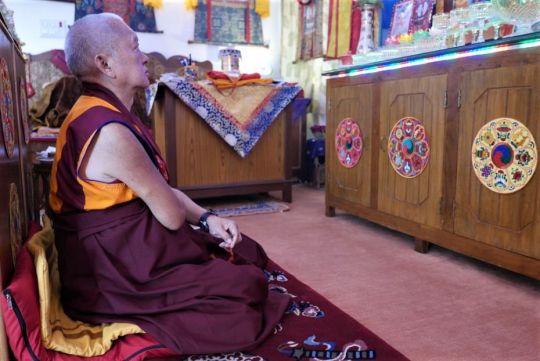
Lama Zopa Rinpoche meditating in his room in Root Institute, Bodhgaya, India. February 2017. Photo by Ven. Roger Kunsang.
In a conversation with a student in 2015, Lama Zopa Rinpoche discussed how to make a difficult decision: whether and when to remove a patient who is not expected to recover from life support. He mentioned the importance of maintaining human life for as long as possible, and thus the benefits of keeping a patient on life support. However, he also acknowledged the high cost and difficulty of keeping someone alive on life support, especially for a lengthy period.
Watch Rinpoche discuss this difficult question on YouTube:
https://youtu.be/GeY25a1nbog
See more videos of Lama Zopa Rinpoche at Rinpoche Available Now:
https://fpmt.org/media/streaming/teachings-of-lama-zopa-rinpoche/
For a range of advice, prayers, and practices related to death and dying, see FPMT.org/Death.
Lama Zopa Rinpoche is the spiritual director of the Foundation for the Preservation of Mahayana Tradition (FPMT), a Tibetan Buddhist organization dedicated to the transmission of the Mahayana Buddhist tradition and values worldwide through teaching, meditation and community service.
- Tagged: advice from lama zopa rinpoche, death and dying, lama zopa rinpoche, lama zopa rinpoche video short, life support, video
28
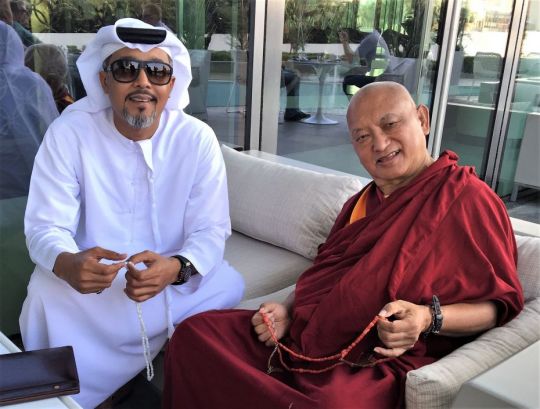
Lama Zopa Rinpoche meets a new friend in Abu Dhabi. Both display their rosaries, the usage of which is shared by Buddhists and Muslims. November, 2016. Photo by Ven. Roger Kunsang.
For Muslims all over the world, Ramadan is a happy time. It just started, on the evening of Friday, May 26, and it runs until late June. Ramadan is the month in which the first verses of the Quran, Islam’s holy book, were revealed to the Prophet Muhammad more than 1,400 years ago. During Ramadan, many Muslims fast from sunrise to sunset and also practice charity: ways to remain aware of God and of the sufferings of the less fortunate.
It is friendly to wish practicing Muslims “Happy Ramadan” or “Ramadan Mubarak” (“Blessed Ramadan”).
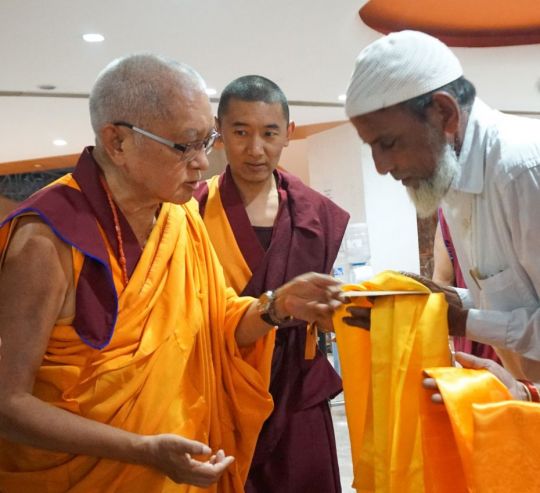
A Muslim student greets Lama Zopa Rinpoche. Bangalore, India, December 2016. Photo by Ven. Lobsang Sherab.
On the value of Islam and other religions to the world, Lama Zopa Rinpoche has explained, “There are many religions in the world, such as Christianity, Hinduism, Islam, and so forth. These different religions are needed. It’s like having different clothes or different kinds of food in a restaurant; we need variety for different people. … We must respect other religions.”
And His Holiness the Dalai Lama? When he was teaching in Strasbourg, France, in 2016, he talked about his concerns about the stereotyping of Muslims. Attendee Laetitia Franceschini, from Toulouse, France, was quoted in a Mandala online article about the Strasbourg teachings. She noted His Holiness’s words about educating people to maintain harmonious relations with others. “I was happy,” she said, “when he spoke about Muslims. His Holiness said that the phrase ‘Muslim terrorist’ is wrong. He said that any person who wants to indulge in violence is not a genuine Buddhist or genuine Muslim. All major religious traditions carry the same message: a message of love, compassion, forgiveness, tolerance, contentment, and self-discipline. It creates stigma for Muslims when one person’s actions brand the whole community. It was inspiring when he spoke about being harmonious with Muslims, and not focusing on one act. That’s very important.”
Lama Zopa Rinpoche also values interfaith work. When he developed his Vast Visions for FPMT, Rinpoche said, “[It would be good] for the centers to arrange regular interfaith dialogues with religious leaders in their local community,” noting that this is one way FPMT can offer service to His Holiness the Dalai Lama and support his objectives.
Happy Ramadan!
Lama Zopa Rinpoche is the spiritual director of the Foundation for the Preservation of Mahayana Tradition (FPMT), a Tibetan Buddhist organization dedicated to the transmission of the Mahayana Buddhist tradition and values worldwide through teaching, meditation, and community service.
24
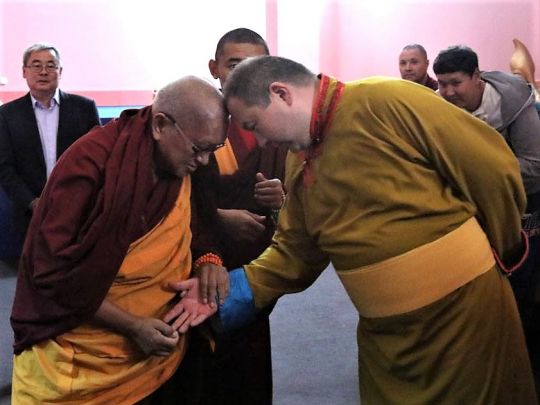
Lama Zopa Rinpoche greeted by Telo Rinpoche in Elista, Kalmykia, Russia, May 2017. Photo by Сохраним Тибет via Facebook.
You can watch Lama Zopa Rinpoche teach live from Moscow starting on Saturday, May 27. The teachings run from May 27 through June 3 and will be live-streamed. Details can be found here: http://en.lamazopa.ru/
Rinpoche’s teachings in Moscow—organized by Ganden Tendar Ling Center—will be streamed on FPMT’s YouTube channel, on Lama Zopa Rinpoche’s Facebook page, and on FPMT’s Facebook page. The live-streamed teachings are scheduled for 7 p.m. local time each evening as follows:
- May 27-June 3, 7 p.m. local time (GMT+3)
Watch here on FPMT’s YouTube channel:
https://www.youtube.com/c/fpmtinc/live
Rinpoche has been teaching in Elista, the capital of Kalmykia, Russia, May 20-24, where he has been hosted by Telo Rinpoche, an important spiritual leader of the Kalmyk people. Kalmykia is a traditionally Buddhist region in Russia.

Lama Zopa Rinpoche blessing cats in Kalmykia, May 2017. Photo via Twitter.
Rinpoche last visited Ganden Tendar Ling Center in Moscow in 2015 when he taught on the “Three Principal Aspects of the Path.”
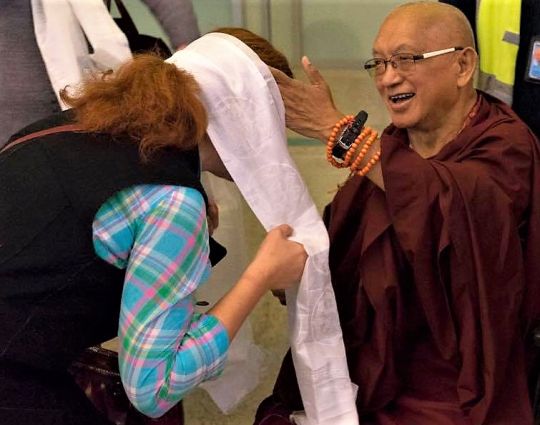
Lama Zopa Rinpoche in Kalmykia, Russia, May 2017. Photo by Mariam Ke via Facebook.
PLEASE NOTE: Live webcasts of Lama Zopa Rinpoche’s teachings are now on YouTube. We will no longer be streaming Rinpoche’s teachings from Livestream.com. Please bookmark this YouTube link for live video of the teachings in Mongolia and Rinpoche’s other future live-streamed teachings:
https://www.youtube.com/c/fpmtinc/live
Rinpoche’s schedule of teachings can be found here:
https://fpmt.org/teachers/zopa/schedule/
Lama Zopa Rinpoche is the spiritual director of the Foundation for the Preservation of Mahayana Tradition (FPMT), a Tibetan Buddhist organization dedicated to the transmission of the Mahayana Buddhist tradition and values worldwide through teaching, meditation, and community service.
- Tagged: animals, lama zopa rinpoche, livestream, russia
22
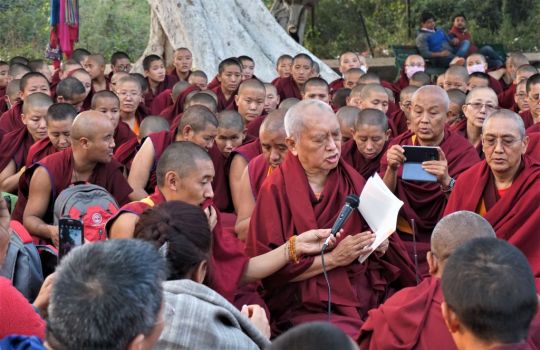
Lama Zopa Rinpoche giving an oral transmission from a Mahamudra text by Panchen Losang Chokyi Gyaltsen, Nalanda, India, January 2017. Photo by Ven. Losang Sherab.
A lung (pronounced loong) is the oral transmission of a text, mantra, or practice by an authorized holder. Lama Zopa Rinpoche explains more about lungs in a video below.
In Tibetan the word for oral transmission is spelled lung (ལུང་). It should not be confused with a different word that sounds similar, lung meaning “wind,” spelled rlung (རླུང་) in Tibetan.
In the video, Lama Zopa Rinpoche emphasizes that lungs come in an unbroken lineage from the Buddha or Lama Tsongkhapa, which gives them blessings. He also mentions that he thinks practices are more effective after we receive a lung—especially if we pay attention while receiving them!
Calling lungs “powerful,” Rinpoche talks in this nine-minute video about the meaning and benefits of lungs and how to receive them. The video is an excerpt from his teachings at the 2016 Light of the Path retreat.
Subtitles of Rinpoche’s words appear in the video if you click “CC” in the bottom right corner, for “Closed Captions”.
Watch Lama Zopa Rinpoche on YouTube as he gives a short talk on lungs:
https://youtu.be/HsMHKfmfwuc
The complete teachings from the 2016 Light of the Path retreat can be found here, including links to transcripts, MP3s, and translations:
https://fpmt.org/media/streaming/teachings-of-lama-zopa-rinpoche/light-of-the-path-teachings-2016/
Register for the 2017 Light of the Path retreat:
http://kadampa-center.org/light-path-retreat-2017
Lama Zopa Rinpoche is the spiritual director of the Foundation for the Preservation of Mahayana Tradition (FPMT), a Tibetan Buddhist organization dedicated to the transmission of the Mahayana Buddhist tradition and values worldwide through teaching, meditation and community service.
17
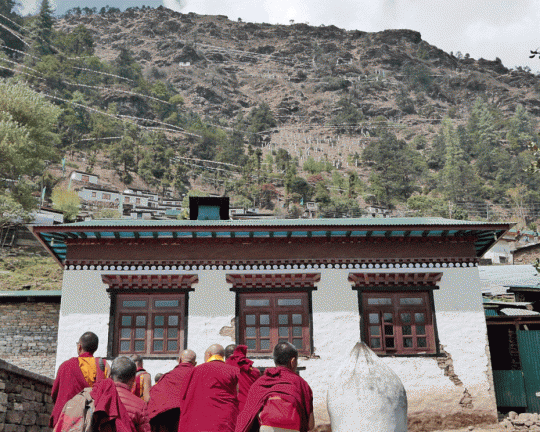
Lama Zopa Rinpoche and others walking toward Trulshik Rinpoche’s monastery, Thubten Choling, Nepal, April 2017. A little above the monastery, where retreat huts are visible, is where Zina Rachevsky did her retreat. Photo by Ven. Roger Kunsang.
In the late 1960s, Zina Rachevsky requested Dharma teachings from Lama Yeshe—and that was the beginning of Lama Yeshe and Lama Zopa Rinpoche teaching Westerners and the planting of the seed that became FPMT. The story is told in detail here. In 1973, Zina Rachevsky undertook a retreat in Nepal near Junbesi, in the Solu Khumbu District. During the retreat, she fell sick, and despite taking medicine, died within a few days.
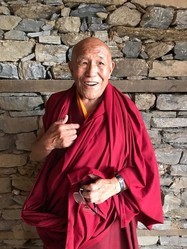
Ven. Bu Norbu, who helped Zina at the time of her death, Nepal, April 2017. Photo by Ven. Roger Kunsang.
While visiting lower Solu Khumbu in April 2017, Lama Zopa Rinpoche went to Thubten Choling, the monastery founded by Trulshik Rinpoche, which was very close to where Zina did her final retreat and passed away. There, Rinpoche heard a first-hand account of Zina’s passing. Rinpoche met with Ven. Bu Norbu, an elderly monk from Thubten Choling who was there at the time. He told Rinpoche about how he had been a friend of Zina and helped her when she was staying above the monastery with her daughter Rhea. He was present when Zina died.
Vens. Roger, Tenzin Legtsok, and Ailsa Cameron were able to walk with him up to the site where Zina’s hut had been, although it is no longer there. A new retreat house is under construction on the same site, with a spectacular view of forested hillsides stretching down to the river valley far below.
With Ven. Legtsok translating, Ven. Bu Norbu told the story of Zina’s passing. This is what he shared as recorded by Ven. Ailsa Cameron:
Ven. Bu Norbu, who was around thirty years old at the time, knew Zina and her daughter, Rhea, well. Zina would shave Bu’s head, and Rhea would tease him by sneaking up on him while he was reading his text and scattering the pages. When Zina suddenly became ill with stomach pain, Trulshik Rinpoche was away in Tengboche, in upper Solu Khumbu. When contacted, Rinpoche sent a message that Zina should take medicine for her illness. Zina had a plentiful supply of Western medicine, which she took, but her condition rapidly deteriorated over the following two days.
Shortly before Zina died, the military police, who had heard that Zina was seriously ill and close to death, came to the retreat house to ask what would be done with Zina’s money and possessions. Rhea, only seven years old at the time, spoke nicely to the police, explaining that there was nothing to worry about as everything had already been given to two Western monks (one of them the American monk, Ngawang Chötak) staying at the monastery. Bu said about Rhea, “She was very brave and clear when she spoke to the military police.”
Bu explained that Zina died sitting up, reciting mantras, and holding a mala in one hand and Rhea’s hand in the other. He added, “Zina was unlike other people.” After Zina’s breath stopped, she remained in meditation for three days, still sitting upright. Bu said that during that time she looked alive.
After three days Zina’s face sagged and its color changed, and her body began to smell. Her body was then carried across the valley to be cremated at Thubten Choling’s consecrated cremation site, which has a mandala etched on a large stone and earth brought from many holy cemeteries in India.
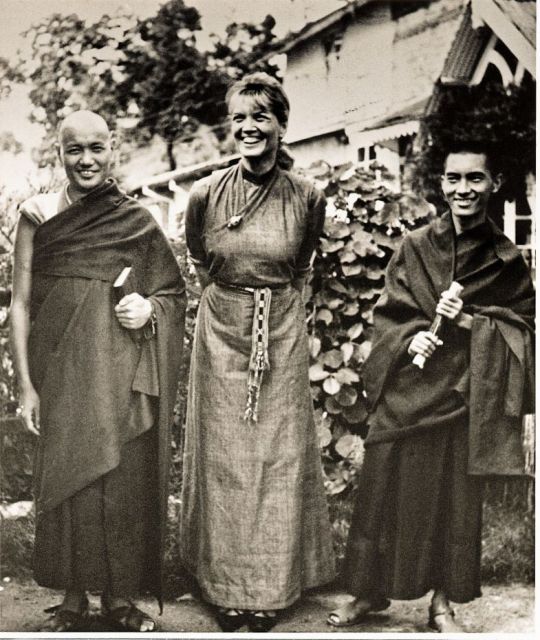
Zina Rachevsky with Lama Yeshe and Lama Zopa Rinpoche before her ordination, 1967. Photo via Lama Yeshe Wisdom Archive.
Lama Zopa Rinpoche is the spiritual director of the Foundation for the Preservation of Mahayana Tradition (FPMT), a Tibetan Buddhist organization dedicated to the transmission of the Mahayana Buddhist tradition and values worldwide through teaching, meditation and community service.
- Tagged: lama zopa rinpoche, nepal, zina rachevsky
15
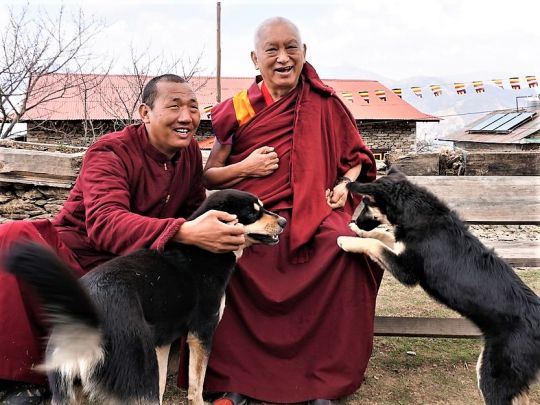
Lama Zopa Rinpoche with Geshe Lozang Rinchen and dogs in front of Thubten Shedrup Ling Monastery (a branch of Kopan Monastery), Solu Khumbu, Nepal, March, 2017. Photo by Ven. Lobsang Sherab.
New photo albums have been added to Lama Zopa Rinpoche’s Photo Gallery, where you can see Rinpoche in action as he travels around the world! Visit FPMT’s website to see a new photo album showing Rinpoche’s March-April visit to Nepal. Albums from 2017 can be found at:
https://fpmt.org/teachers/zopa/gallery/#2017
Rinpoche spent the beginning of the year in India, visiting Root Institute, Maitreya School, and Maitri Charitable Project in Bodhgaya; going on pilgrimage to the ruins of Nalanda University and the stupa at Sarnath; and being offered a long life puja at Yulo Koepa (Tara Temple) in Sarnath, which is a project of Kopan Nunnery. In late February, Rinpoche returned to Kopan Monastery in Nepal for Losar (Tibetan New Year) and the March enthronement of Thubten Rigsel Rinpoche, the reincarnation of Khensur Rinpoche Lama Lhundrup.
Rinpoche then spent time at Thubten Shedrup Ling Monastery, which is a branch of Kopan Monastery and next to Sagarmatha Lower Secondary School, in lower Solu Khumbu District. Rinpoche blessed the children who are students at the school, which is overseen by Kopan Monastery and supported by FPMT’s Social Service Fund. Rinpoche made a visit to Thubten Choling Monastery in Junbesi. Then he went to Maratika Caves in Khotang District.
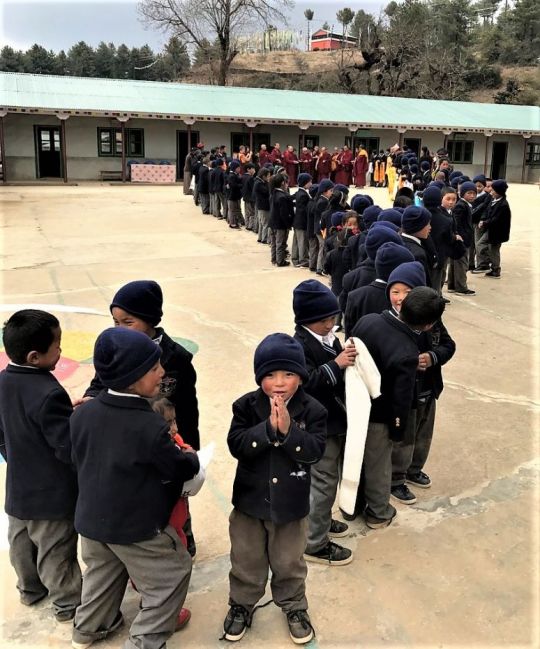
Children of Sagarmatha Lower Secondary School lined up on the assembly ground with Lama Zopa Rinpoche in background. The older children look after the younger ones. Chailsa, Nepal, March 2017. Photo by Ven. Roger Kunsang.
Rinpoche has most recently been teaching in Mongolia. [Please see “CORRECTED–Lama Zopa Rinpoche in Mongolia: Update,” to read the corrected version of this post on Rinpoche’s Mongolia visit.]
More information, photos and updates about FPMT spiritual director Lama Zopa Rinpoche can be found on Rinpoche’s homepage. If you would like to receive news of Lama Zopa Rinpoche via email, sign up to Lama Zopa Rinpoche News.
- Tagged: lama zopa rinpoche, photo gallery
14
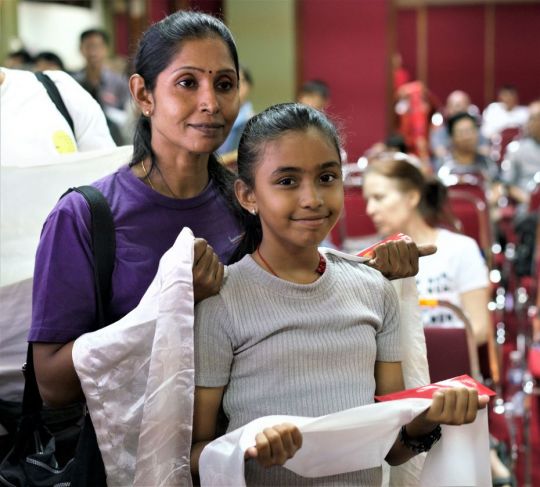
A mother and daughter offer khatas to Lama Zopa Rinpoche, Penang, Malaysia, April 2016. Photo by Bill Kane.
Lama Zopa Rinpoche often talks about mother sentient beings—but what does he say about actual mothers?
Rinpoche wrote to a student in 2014 about how to think about her mother, saying, “The way to think is that you received all the past happiness from beginningless time from your mother, and on top of that all your present happiness, and on top of that all the future happiness. Not only this life’s happiness, but ultimate happiness, liberation from samsara—the total cessation of all the obscurations and the completion of all the realizations—full enlightenment.”
He added, “Your mother is most kind, most dear, most precious, your wish-fulfilling one, therefore from your side offer her every single benefit that you can, because she is the most important one!”
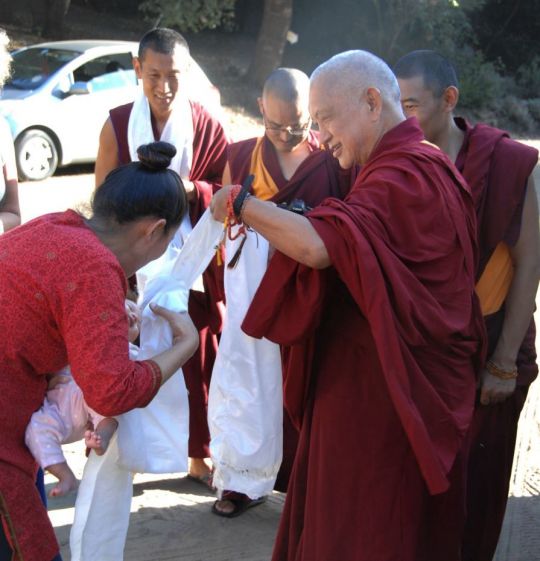
Lama Zopa Rinpoche blesses a mother and baby, Land of Medicine Buddha, USA, October, 2015. Photo by Bob Cayton.
Continuing, Rinpoche said, “Your mother is cherished most by numberless bodhisattvas, not just by one bodhisattva, but by numberless bodhisattvas … For the numberless bodhisattvas, your mother is more precious than the whole sky filled with wish-granting jewels—not only filled with dollars and diamonds but with wish-granting jewels … Now the buddhas, Shakyamuni Buddha and all the buddhas cherish your mother most, more than Buddha himself … Numberless bodhisattvas cherish her most, they work for her.”
Rinpoche concluded, “Therefore you can see how important it is for you, due to your connection with your mother this time, every single benefit that you can offer her—this is the best offering to numberless bodhisattvas and numberless buddhas. You can see that even offering a small benefit to her is the best offering!”
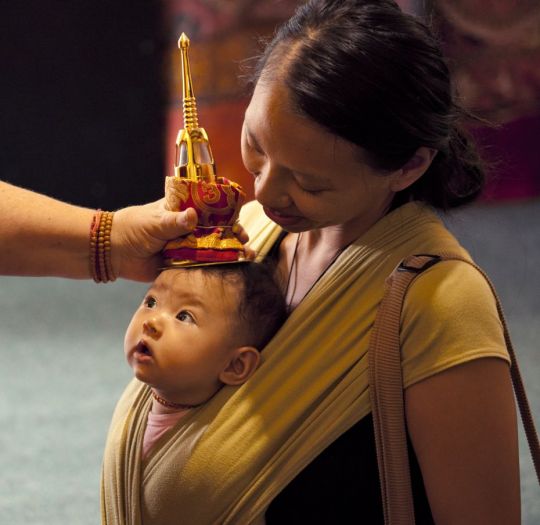
A child receives a blessing during the Maitreya Relic Tour, Mullumbimby, Australia, 2012. Photo by Andy Melnic.
Read the full teaching here:
https://www.lamayeshe.com/advice/your-mother-most-kind-most-dear-most-precious
Lama Zopa Rinpoche is the spiritual director of the Foundation for the Preservation of Mahayana Tradition (FPMT), a Tibetan Buddhist organization dedicated to the transmission of the Mahayana Buddhist tradition and values worldwide through teaching, meditation, and community service.
- Tagged: lama zopa rinpoche, motherhood
10
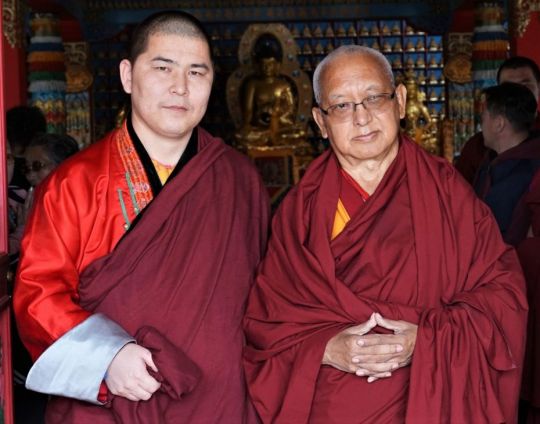
Lama Zopa Rinpoche with Danzan Ravjaa Rinpoche, the 9th reincarnation of the Lama of the Gobi, Mongolia, May 2017. Photo by Ven. Lobsang Sherab.
CORRECTED, May 11—This post has been corrected. We apologize for the errors that appeared in this blog as it was originally published on May 10.
Lama Zopa Rinpoche—who has been touring Mongolia this month, giving teachings, blessings, and initiations—visited Dolma Ling (Dulmaling) Nunnery in Ulaanbaatar on May 2.
The Dolma Ling existed long in the past, but was partially destroyed in the 1930s along with many other religious sites in Mongolia. Greater religious freedom in the 1990s led to initial steps to re-establish the site, and in 2001, the temple and grounds were offered to Lama Zopa Rinpoche. The nunnery’s original building, which is unique and beautiful, is still to be found at the site, and is awaiting restoration.
Rinpoche spent time talking with the Dolma Ling nuns about improvements needed at the nunnery, and discerning next steps for moving forward.
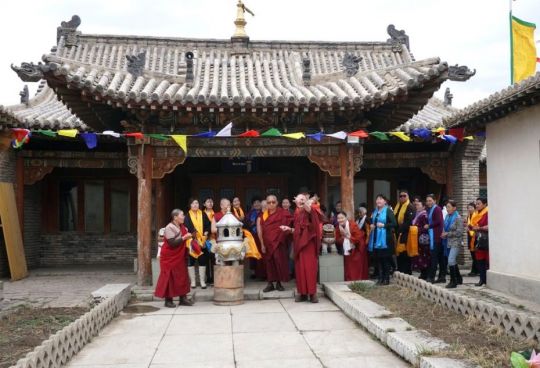
Lama Zopa Rinpoche standing in front of the original building of the historic Dolma Ling Nunnery, Mongolia, 2017. Photo by Ven. Lobsang Sherab.
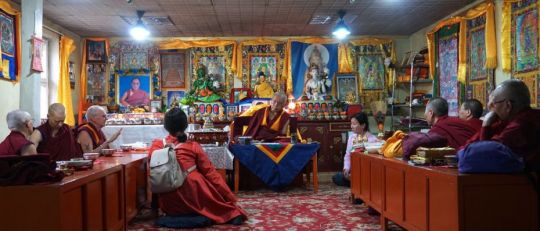
Lama Zopa Rinpoche meeting with nuns at Dolma Ling Nunnery, Mongolia, May 2017. Photo by Ven. Lobsang Sherab.
Dolma Ling is located on the same land as the Lamp of the Path soup kitchen. This much-needed social service project offers lunch to more than eighty homeless people a day in a small building.
“The soup kitchen is small but very inspiring! Particularly in the winter, it seems to be a lifesaver for the many homeless people in this area, which is quite a poor area and a long way from other services,” Ven. Holly Ansett reported. “The project grows its own vegetables during the short spring/summer growing season, which was very heartening for us to see.”
On May 3-4, Rinpoche and about twenty-five others, including several monks and the abbot from Idgaa Choizinling Monastery (ICM) in Ulaanbaatar drove for close to seven hours into the Gobi Desert (southeast towards China). Halfway there, Rinpoche and the group stopped for a picnic lunch; monks from ICM had come the day before to set up a beautiful ger (a Mongolian tent or yurt) for the group where they offered lunch. Although a sand storm made getting from the vehicles into the ger a bit tumultuous, once inside, everyone found it very cozy. The ger was set up in a place called Choyr. In the past, there was a monastery there with 1,500 monks, but this was destroyed in the 1930s. Not far away was a very blessed rock carving of Hayagriva Garuda Vajrapani. Thus Choyr is considered a holy place. The area was under the ocean millions of years ago, and the rocks there are unusual and known for containing fossils.
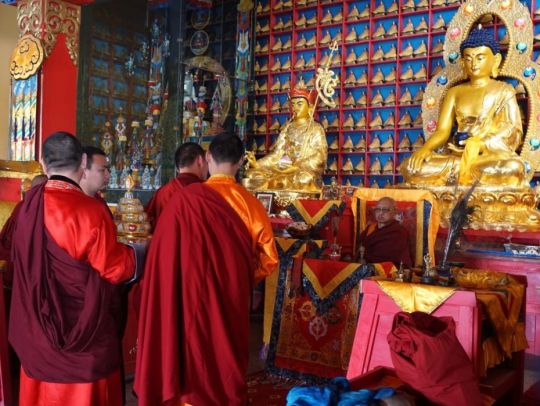
Monks of Khamar Monastery offering mandala to Rinpoche. Mongolia, May 2017. Photo by Ven. Lobsang Sherab.
The next day the group visited Khamar Monastery, which is located in a desert—very stark and dry, with not a tree in sight. When Rinpoche arrived, the monks were doing Tara practice; they quickly offered Rinpoche a mandala offering. Rinpoche also met Danzan Ravjaa Rinpoche, who is the 9th incarnation of the Lama of the Gobi. Rinpoche also visited the small nunnery next door to the monastery.
Next Rinpoche went to Shambhala land—an area of stupas, temples, and other monuments reputed to be a gateway to the legendary Shambhala—to visit caves where past meditators stayed in retreat.
From there, Rinpoche and the group headed back to Ulaanbaatar. As they drove, they passed many herds of wild horses, goats, sheep, cows, and camels. Rinpoche stopped a number of times to bless the animals. He had a portable loudspeaker and, in the hope of leaving imprints, recited many prayers and mantras, such as the long and longest Chenrezig mantras, the Medicine Buddha mantra, the Maitreya Buddha mantra, the Namgyälma mantra, and lamrim prayers.

Wild mares that Rinpoche blessed in the Gobi Desert, Mongolia, May 2017. Photo by Ven. Lobsang Sherab
“Many times the animals actually listened, ears pricked. When we stopped to bless the wild mares, for example, they actually ran up to the side of the car where Rinpoche was reciting so they were close. It really seemed that they wanted to be able to hear his voice,” Ven. Holly said.
On the way back to Ulaanbaatar, the group stopped at the same ger as before for a late lunch, and the monks from ICM requested an oral transmission from Rinpoche. He gave a short teaching and oral transmission in the ger of the Four Mindfulnesses, a teaching by Manjushri to Lama Tsongkhapa. Rinpoche gave the teaching and transmission in Tibetan, and they were translated into Mongolian and English. The group left the ger as the sun was setting, and the whole sky turned red. “It was an incredible sight,” reported Ven. Holly, “The desert views were breathtaking!” The group arrived back at FPMT’s center in Ulaanbaatar at midnight.
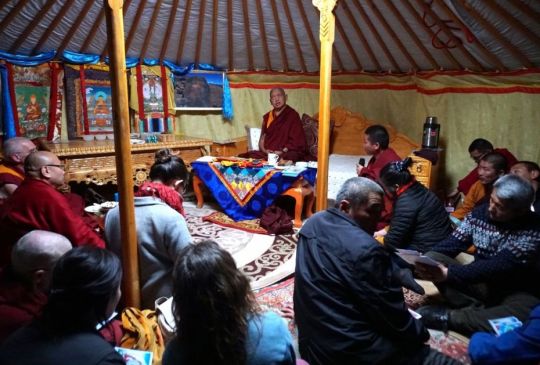
In a ger (yurt) in Choyr in the Gobi Desert, Rinpoche giving an oral transmission of the Four Mindfulnesses, a teaching by Manjushri to Lama Tsongkhapa, Mongolia, May 2017. Photo by Ven. Lobsang Sherab.
On May 6, Rinpoche went to visit the FPMT center in Darkhan, in Northern Mongolia, the Golden Light Sutra Center (GLS), which is a four-hour drive north towards the border with Russia. On the way were beautiful mountain landscapes, though with hardly any trees. Again, the group saw many animals, including wild horses, sheep, goats, and cattle. Rinpoche stopped over and over to bless animals, and the drive took extra time due to this. The group was accompanied by the abbot of ICM as well as Geshe Thubten Zopa from Sera Je Monastery. Geshe-la is assisting the tantric college at Ganden Monastery in Ulaanbaatar, and also teaches at the FPMT center in Ulaanbaatar, Ganden Do Ngag Shedrup Ling. While in Darkhan, Rinpoche had a short meeting with the board of GLS center, a short TV interview, and enjoyed both lunch and dinner with the governor of Darkhan province, and with the city governor who is on the GLS board.
The next day Rinpoche visited Ganden Tara Monastery and gave oral transmissions of the Thirty-Five Buddhas and Seven Medicine Buddhas, and a prayer to spread the teachings of Lama Tsongkhapa to the thirty or so monks. Rinpoche then gave a public talk to more than 300 people. In the talk, he gave advice on how to meditate on emptiness, including how to do one’s daily activities with the mind in emptiness and live one’s whole life doing all activities from this mind.
Leaving Darkhan, the group drove the four hours back to Ulaanbaatar, again stopping a number of times to bless the many animals along the road.
Rinpoche’s teachings before the Great Chenrezig Initiation at Idgaa Choizinling Monastery—organized by Ganden Do Ngag Shedrup Ling—will be streamed live on FPMT’s YouTube channel, on Lama Zopa Rinpoche’s Facebook page, and on FPMT’s Facebook page.
The live-streamed teachings are scheduled for:
- May 10, 7 p.m. local time (GMT+8)
- May 11-12, 6 p.m. local time (GMT+8)
Watch here on FPMT’s YouTube channel:
https://www.youtube.com/c/fpmtinc/live
PLEASE NOTE: Live webcasts of Lama Zopa Rinpoche’s teachings are now on YouTube. We will no longer be streaming Rinpoche’s teachings from Livestream.com. Please bookmark this YouTube link for live video of the teachings in Mongolia and Rinpoche’s other future live-streamed teachings:
https://www.youtube.com/c/fpmtinc/live
Lama Zopa Rinpoche is the spiritual director of the Foundation for the Preservation of Mahayana Tradition (FPMT), a Tibetan Buddhist organization dedicated to the transmission of the Mahayana Buddhist tradition and values worldwide through teaching, meditation, and community service.
- Tagged: animals, fpmt mongolia, lama zopa rinpoche, mongolia, video
8
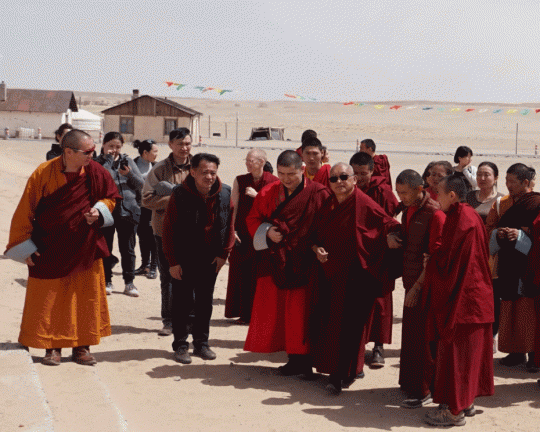
Lama Zopa Rinpoche visiting Khamar Monastery in the eastern Gobi Desert, Mongolia, May 2017. Photo by Ven. Lobsang Sherab.
You can watch Lama Zopa Rinpoche teach live from Mongolia May 10-12!
Rinpoche’s teachings before the Great Chenrezig Initiation at Idgaa Choizinling Monastery—organized by Ganden Do Ngag Shedrup Ling, the FPMT center in Ulaanbaatar—will be streamed live on FPMT’s YouTube channel, on Lama Zopa Rinpoche’s Facebook page, and on FPMT’s Facebook page. The live-streamed teachings are scheduled for:
- May 10, 7 p.m. local time (GMT+8)
- May 11-12, 6 p.m. local time (GMT+8)
Watch here on FPMT’s YouTube channel:
https://www.youtube.com/c/fpmtinc/live
Rinpoche arrived in Mongolia in late April and has traveled into the Gobi Desert, visiting sacred sites and a monastery there, and then to Darkhan, Mongolia’s second largest city, where Golden Light Sutra Center is located.
Rinpoche last visited Mongolia in 2013 when he taught for several weeks at Idgaa Choizinling during a month-long 100 million mani retreat, hosted by FPMT Mongolia. Read about the visit in “Rejoicing in the 100 Million Mani Retreat in Mongolia,” from Mandala January-March 2014.
PLEASE NOTE: Live webcasts of Lama Zopa Rinpoche’s teachings are now on YouTube. We will no longer be streaming Rinpoche’s teachings from Livestream.com. Please bookmark this YouTube link for live video of the teachings in Mongolia and Rinpoche’s other future live-streamed teachings:
https://www.youtube.com/c/fpmtinc/live
Rinpoche’s schedule of teachings can be found here:
https://fpmt.org/teachers/zopa/schedule/
Lama Zopa Rinpoche is the spiritual director of the Foundation for the Preservation of Mahayana Tradition (FPMT), a Tibetan Buddhist organization dedicated to the transmission of the Mahayana Buddhist tradition and values worldwide through teaching, meditation, and community service.
- Tagged: fpmt mongolia, ganden do ngag shedrup ling, lama zopa rinpoche, mongolia, rinpoche available now
3
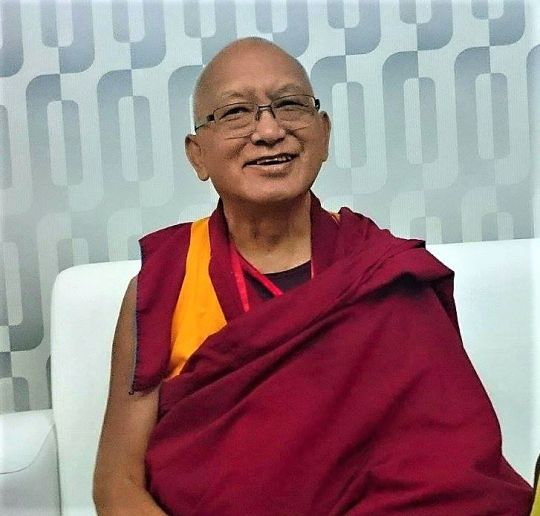
Lama Zopa Rinpoche in Mongolia, April 29, 2017. Photo by Ueli Minder via FB.
Lama Zopa Rinpoche has arrived safely in Mongolia, traveling from Nepal. Rinpoche is staying at the FPMT center in Ulaanbaatar, Mongolia, called Ganden Do Ngag Shedrub Ling Center. He will also be visiting the Golden Light Sutra Center in Darkhan, Mongolia.
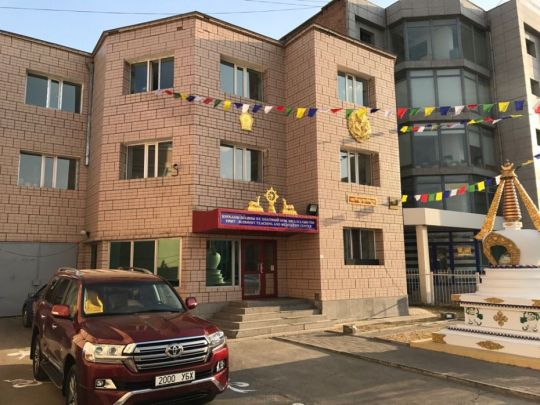
The FPMT center in Ulaan Bator, Mongolia. Rinpoche’s room is on the top floor. May 1, 2017.
Rinpoche was greeted by enthusiastic supporters on his arrival in Mongolia, enjoyed a vegetarian “Mongolian hotpot” with his hosts, and met with Dharma center members and their children.
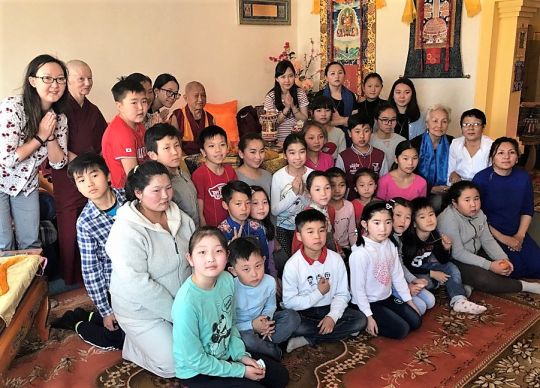
Rinpoche with the children who attend the Dharma classes at the center in Ulaanbaatar, Mongolia. May 2017.
While in Mongolia, Rinpoche is expected to give Dharma talks, a Great Chenrezig Initiation, and a long life initiation. Dharma center members are planning to offer him a long life puja.
Rinpoche’s schedule of teachings can be found here: https://fpmt.org/teachers/zopa/schedule/.
Lama Zopa Rinpoche is the spiritual director of the Foundation for the Preservation of Mahayana Tradition (FPMT), a Tibetan Buddhist organization dedicated to the transmission of the Mahayana Buddhist tradition and values worldwide through teaching, meditation, and community service.
- Tagged: fpmt mongolia, lama zopa rinpoche, mongolia
1
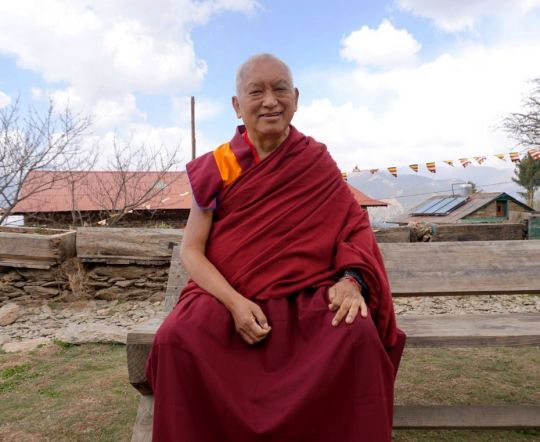
Lama Zopa Rinpoche in front of Thubten Shedrup Ling Monastery, Chailsa, Nepal, March 2017. Photo by Ven. Lobsang Sherab.
In March 2017, Lama Zopa Rinpoche visited the village of Chailsa, in Solu Khumbu, Nepal. Among various activities there, he visited Sagarmatha Secondary School. More than two years ago, FPMT took on the commitment of sponsoring this school, which has about 120 students, with its Social Service Fund. Kopan Monastery oversees the management of the school.
Chailsa is in Solu Khumbu, north-eastern Nepal, the district where Lama Zopa Rinpoche was born and where many Himayalan Buddhists live. Chailsa is in the southern part of the district near Salleri, the district headquarters. The area is remote but still reachable by jeep—a day-long drive from Kathmandu over difficult roads.
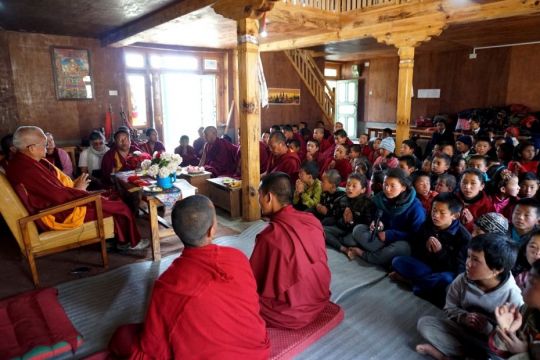
Lama Zopa Rinpoche explains how to do water bowl offerings to the children of Sagarmatha school. Chailsa, Nepal, March 2017. Photo by Ven. Lobsang Sherab.
Rinpoche blessed the school and was welcomed by the children with a traditional dance. He gave a talk to them, giving them an explanation of how to do water bowls. He also sponsored a picnic for the children and their teachers. The school provided prizes for the children’s exams, which Rinpoche handed out. Rinpoche and Kopan are working to identify the needs of the schoolchildren so they can ensure that the necessary donations are organized.
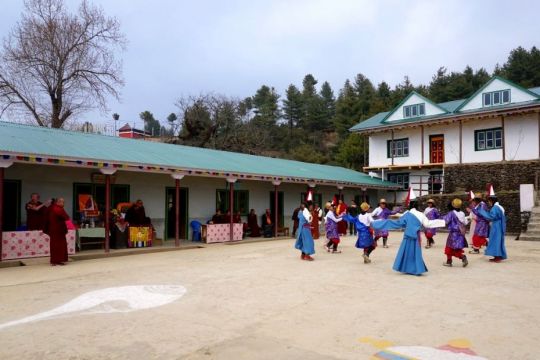
Schoolchildren offering Lama Zopa Rinpoche a traditional dance. Chailsa, Nepal, March 2017. Photo by Ven. Lobsang Sherab.
In the village, Rinpoche gave a lung and some commentary for the Vajrayogini three-year retreat privately to some students, one who is planning to soon do the retreat. He also gave a short commentary to the local gompa keeper of the torma gyatsa practice. Finally, he offered an Amitabha long life initiation with teachings.
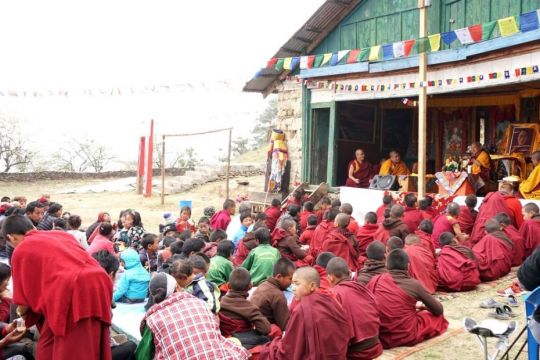
Lama Zopa Rinpoche offering an Amitabha long life initiation, Chailsa, Nepal, March 2017. Photo by Ven. Lobsang Sherab.
Rinpoche also visited Thubten Shedrup Ling. This monastery, located in Chailsa, is under the care of Kopan Monastery, which took it over in 2004. It has only a few dozen residents, and with the help of Kopan, it has been partially rebuilt. It offers an opportunity for young people to receive a monastic education, to live in their vows in a monastic environment, and study and practice the teachings of the Buddha.
Rinpoche is also trying to locate land in Chailsa on which to keep goats and other animals whose lives have been saved.
On the trip, Rinpoche also went to Thubten Chöling, a large monastery built by the late Trulshik Rinpoche in the 1960s in Junbesi, which is near Salleri and on the Jiri-Everest trekking trail.
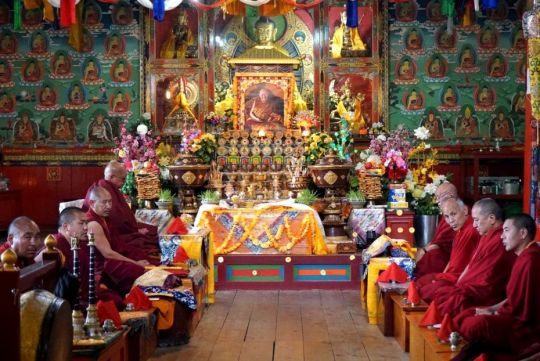
Lama Zopa Rinpoche with the monks and nuns of Thupten Chöling Monastery doing prayers in front of the Holy Body of Trulshik Rinpoche. Solu Khumbu, Nepal, March 2017. Photo by Ven. Lobsang Sherab.
One of the greatest living masters of the Nyingma and rime traditions of Tibetan Buddhism, Trulshik Rinpoche, who passed away in 2011, was one of Rinpoche’s gurus. While at Thubten Chöling, Rinpoche offered to sponsor a portion of the costs of a stupa being constructed there. He paid his respects to Trulshik Rinpoche’s holy body (which is in a mandala house above the altar), made prayers, and made offerings to each of the approximately 400 Sangha present. Rinpoche’s assistant, Ven.Roger, requested the Sangha to do an extensive Medicine Buddha puja for Rinpoche’s health and long life, following the advice of Khadro-la (Rangjung Neljorma Khadro Namsel Drönme).
Lama Zopa Rinpoche is the spiritual director of the Foundation for the Preservation of Mahayana Tradition (FPMT), a Tibetan Buddhist organization dedicated to the transmission of the Mahayana Buddhist tradition and values worldwide through teaching, meditation, and community service.
26
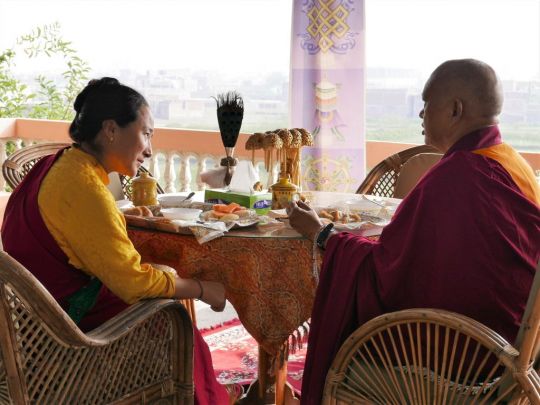
Lama Zopa Rinpoche and Khadro-la (Rangjung Neljorma Khadro Namsel Drönme) enjoy a vegetarian meal at Root Institute in Bodhgaya, India, January 2017. Photo by Ven. Roger Kunsang.
Lama Zopa Rinpoche cares deeply about animals and uses every possible opportunity to bless them with prayers, mantras, holy objects, and other means. A short video of Lama Zopa Rinpoche blessing sentient beings in a lake in Washington State, US, appears below.
Rinpoche also avoids eating other living beings. He is a vegetarian and often urges his students not to eat meat. He gave the following advice in 2014.
Rinpoche said, “About meat, I would like to say, please reduce eating meat, as it does so much harm to others and even to one’s own body. This is not just belief, it’s now even accepted scientifically. If you can avoid meat, it’s so good. Wow, wow, wow!”
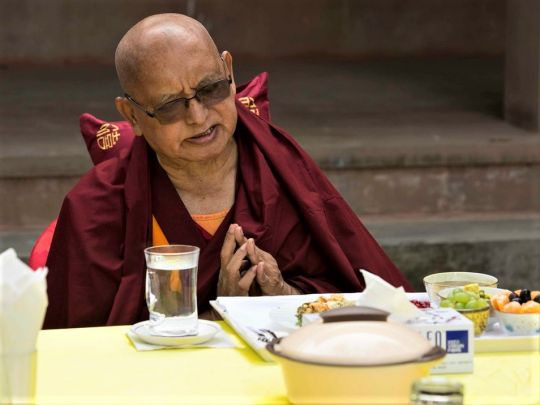
Rinpoche blessing the vegetarian lunch offered to all after his long life puja in Sarnath, India, January 2017. Photo by Paolo Regis.
Rinpoche focused on avoiding meat as the most compassionate approach, saying, “All the buddhas and bodhisattvas will be so happy with you, just as a mother loves her beloved child, cherishing her child so much. When her child does something good that makes the mother so unbelievable happy. So if possible, abandon meat or cut down eating meat. The conclusion is that if less people eat meat, that means more animals won’t suffer from being killed. That’s the benefit, so please think about this.”
Rinpoche also advised considering carefully the teachings of the lamrim. “Don’t think about the pleasure of eating [meat] without thinking about reincarnation, karma, and the lower realms. Instead of just thinking about the pleasure of eating meat, think about the suffering of the animals when they are being killed, and think of yourself being at the butcher’s place, about to be killed. How does that feel? If you’re about to be killed, like the animals, how does that feel? Do you like that? If you really think Dharma is to not harm sentient beings, then don’t eat meat, or at least eat very little.”
Rinpoche added that one can remain healthy without meat, explaining, “Not eating meat is OK. So many young people in the West don’t eat meat and are still healthy; they can supplement their diet with other things. So many people [are vegetarian] now, young and old, and its increasing more and more.”
Watch Rinpoche bless living beings in Omak Lake in Washington State, US, on YouTube:
https://youtu.be/zoFxyLZPUiQ
Lama Zopa Rinpoche is the spiritual director of the Foundation for the Preservation of Mahayana Tradition (FPMT), a Tibetan Buddhist organization dedicated to the transmission of the Mahayana Buddhist tradition and values worldwide through teaching, meditation, and community service.
- Home
- News/Media
- Study & Practice
- About FPMT Education Services
- Latest News
- Programs
- New to Buddhism?
- Buddhist Mind Science: Activating Your Potential
- Heart Advice for Death and Dying
- Discovering Buddhism
- Living in the Path
- Exploring Buddhism
- FPMT Basic Program
- FPMT Masters Program
- FPMT In-Depth Meditation Training
- Maitripa College
- Lotsawa Rinchen Zangpo Translator Program
- Universal Education for Compassion & Wisdom
- Online Learning Center
- Prayers & Practice Materials
- Overview of Prayers & Practices
- Full Catalogue of Prayers & Practice Materials
- Explore Popular Topics
- Benefiting Animals
- Chenrezig Resources
- Death & Dying Resources
- Lama Chopa (Guru Puja)
- Lama Zopa Rinpoche: Compendium of Precious Instructions
- Lama Zopa Rinpoche: Life Practice Advice
- Lama Zopa Rinpoche Practice Series
- Lamrim Resources
- Mantras
- Prayer Book Updates
- Purification Practices
- Sutras
- Thought Transformation (Lojong)
- Audio Materials
- Dharma Dates – Tibetan Calendar
- Translation Services
- Publishing Services
- Teachings and Advice
- Find Teachings and Advice
- Lama Zopa Rinpoche Advice Page
- Lama Zopa Rinpoche: Compendium of Precious Instructions
- Lama Zopa Rinpoche Video Teachings
- ༧སྐྱབས་རྗེ་བཟོད་པ་རིན་པོ་ཆེ་མཆོག་ནས་སྩལ་བའི་བཀའ་སློབ་བརྙན་འཕྲིན།
- Podcasts
- Lama Yeshe Wisdom Archive
- Buddhism FAQ
- Dharma for Young People
- Resources on Holy Objects
- Ways to Offer Support
- Centers
- Affiliates Area
- Teachers
- Projects
- Charitable Projects
- Make a Donation
- Applying for Grants
- News about Projects
- Other Projects within FPMT
- Support International Office
- Projects Photo Galleries
- Give Where Most Needed
- FPMT
- Shop
Translate*
*powered by Google TranslateTranslation of pages on fpmt.org is performed by Google Translate, a third party service which FPMT has no control over. The service provides automated computer translations that are only an approximation of the websites' original content. The translations should not be considered exact and only used as a rough guide.Since the I that exists is merely imputed, there is nothing to cherish, nothing to cling to. Good-bye to depression, worries and fears.







